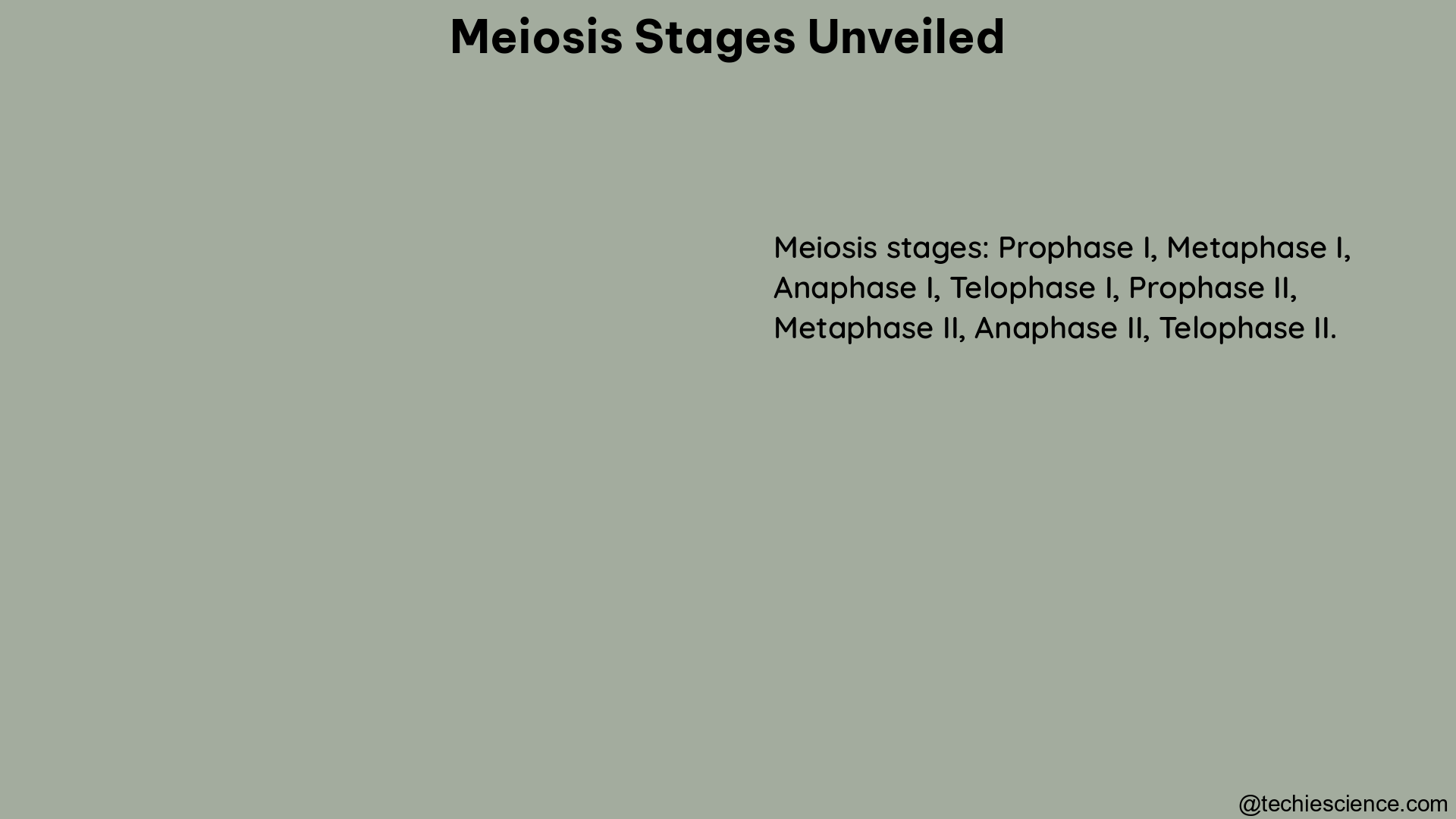Meiosis is a complex and highly regulated cell division process that results in the production of haploid gametes, which is crucial for sexual reproduction. The stages of meiosis can be broken down into several key events, each with its own unique characteristics and duration.
Understanding the Stages of Meiosis
Meiosis is a two-part cell division process that involves two consecutive cell divisions, known as meiosis I and meiosis II. Each stage of meiosis has its own distinct features and plays a crucial role in the formation of haploid gametes.
Meiosis I
- Prophase I:
- Chromosomes condense and become visible.
- Homologous chromosomes pair up and form bivalents (also known as tetrads).
- Crossing over occurs, where genetic material is exchanged between homologous chromosomes.
-
The nuclear envelope breaks down, and the spindle apparatus begins to form.
-
Metaphase I:
- Bivalents align at the equatorial plate of the cell.
-
Microtubules from the spindle apparatus attach to the kinetochores of the chromosomes.
-
Anaphase I:
- Homologous chromosomes separate and move towards opposite poles of the cell.
-
The cell begins to divide, and the cytoplasm starts to constrict.
-
Telophase I:
- The cell completes division, and two daughter cells are formed, each with a haploid set of chromosomes.
- The nuclear envelope reforms, and the chromosomes begin to decondense.
Meiosis II
- Prophase II:
- The nuclear envelope breaks down, and the spindle apparatus reforms.
-
Chromosomes condense again, and the sister chromatids become visible.
-
Metaphase II:
- The sister chromatids align at the equatorial plate of the cell.
-
Microtubules from the spindle apparatus attach to the kinetochores of the sister chromatids.
-
Anaphase II:
- The sister chromatids separate and move towards opposite poles of the cell.
-
The cell begins to divide, and the cytoplasm starts to constrict.
-
Telophase II:
- The cell completes division, and four daughter cells are formed, each with a haploid set of chromosomes.
- The nuclear envelope reforms, and the chromosomes begin to decondense.
Regulation of Meiotic Progression

The duration and characteristics of meiotic stages can vary significantly between organisms and even between wild-type and mutant individuals. This variability highlights the complex regulation of meiotic progression.
A study on Arabidopsis thaliana found that the duration of metaphase I and cytokinesis was significantly longer in the cdkd;3‐3 smg7‐6 mutant compared to the wild type. These findings suggest that the regulation of meiotic progression is critical for maintaining proper chromosome segregation and fertility.
Similarly, a study on Caenorhabditis elegans revealed that the duration of leptotene, zygotene, and pachytene stages varied significantly, with leptotene being the shortest stage and pachytene being the longest. These results emphasize the complexity and variability of meiotic progression, even within a single organism.
Key Events in Meiosis
Meiosis is characterized by several key events, including chromosome pairing, crossing over, and segregation. These events are tightly regulated by a network of proteins and enzymes.
During meiosis I, homologous chromosomes pair and undergo crossing over, which results in the exchange of genetic material between the two chromosomes. This process is crucial for generating genetic diversity and is regulated by various proteins and enzymes.
In meiosis II, sister chromatids separate and are distributed to separate daughter cells. This process is similar to mitosis, but with the key difference being that only half the number of chromosomes are present.
Conclusion
The stages of meiosis are highly regulated and involve a complex series of events that are critical for the production of haploid gametes. The duration and characteristics of these stages can vary significantly between organisms and mutants, highlighting the importance of understanding the molecular mechanisms that regulate meiotic progression.
By unveiling the intricate details of meiosis stages, this comprehensive guide provides a valuable resource for biology students and researchers interested in understanding the fundamental processes of sexual reproduction and genetic diversity.
References:
- A complex role of Arabidopsis CDKD;3 in meiotic progression and fertility. Plant Physiology, 181(2), 781-796.
- Time-course analysis of early meiotic prophase events informs meiotic chromosome dynamics in Caenorhabditis elegans. PLoS Genetics, 13(5), e1006735.
- Mitosis – an overview | ScienceDirect Topics. https://www.sciencedirect.com/topics/agricultural-and-biological-sciences/mitosis
- 1 Introduction – CiteSeerX. https://citeseerx.ist.psu.edu/document?doi=5359b79e0637959f404dc0dcc03288a43512fa35&repid=rep1&type=pdf
- Meiosis | Cell division | Biology (article) – Khan Academy. https://www.khanacademy.org/science/ap-biology/heredity/meiosis-and-genetic-diversity/a/phases-of-meiosis

The lambdageeks.com Core SME Team is a group of experienced subject matter experts from diverse scientific and technical fields including Physics, Chemistry, Technology,Electronics & Electrical Engineering, Automotive, Mechanical Engineering. Our team collaborates to create high-quality, well-researched articles on a wide range of science and technology topics for the lambdageeks.com website.
All Our Senior SME are having more than 7 Years of experience in the respective fields . They are either Working Industry Professionals or assocaited With different Universities. Refer Our Authors Page to get to know About our Core SMEs.